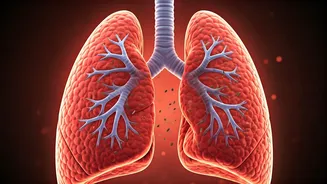Pollution's Silent Invasion
Air pollution has become a significant public health concern, especially in densely populated areas like many Indian cities. It’s an insidious threat,
silently impacting various aspects of our health. The pollutants in the air, including particulate matter (PM2.5 and PM10), nitrogen oxides, sulfur dioxide, and ground-level ozone, enter our bodies through respiration. These substances irritate the airways and lungs, causing inflammation and increasing susceptibility to respiratory infections. Furthermore, these pollutants can move beyond the lungs and enter the bloodstream, traveling to other organs and contributing to cardiovascular issues and other systemic diseases. The severity of the impact depends on the concentration of pollutants, the duration of exposure, and individual susceptibility, emphasizing the urgent need for awareness and protective measures. Considering India's specific environmental conditions, the article aims to address how pollution directly affects the body.
Respiratory System's Battle
The respiratory system is at the forefront of the battle against air pollution. When polluted air is inhaled, the lungs become the primary point of contact for harmful particles and gases. This contact leads to a cascade of negative effects. Initially, there can be irritation and inflammation of the airways, leading to coughing, wheezing, and shortness of breath. Prolonged exposure can worsen existing conditions like asthma and chronic obstructive pulmonary disease (COPD). It can trigger asthma attacks in susceptible individuals and exacerbate symptoms for those with existing respiratory issues. Additionally, consistent exposure to pollutants increases the risk of developing respiratory infections, such as bronchitis and pneumonia. Over time, chronic exposure can lead to structural changes in the lungs, reducing their capacity and efficiency. The link between air pollution and an increased risk of lung cancer has also been well-established, reinforcing the importance of protecting the respiratory system.
Cardiovascular Impact
Air pollution isn't just a respiratory issue; it's also a significant risk factor for cardiovascular problems. Inhaled pollutants can enter the bloodstream and cause systemic inflammation, which is known to accelerate the development of atherosclerosis (the buildup of plaque in arteries). The fine particulate matter in polluted air can trigger blood clots, which can lead to heart attacks and strokes. Studies have shown a direct correlation between high levels of air pollution and increased hospital admissions for cardiovascular events. Long-term exposure to polluted air is associated with a higher risk of developing hypertension (high blood pressure) and heart disease. Protecting your cardiovascular health during times of high pollution involves minimizing exposure and implementing preventive strategies to protect your cardiovascular health and to reduce the likelihood of experiencing any heart-related problems. It emphasizes the importance of understanding and addressing the broader health implications of air pollution.
Brain's Vulnerability
The brain is also vulnerable to the effects of air pollution. Studies show a connection between air pollution exposure and cognitive impairment. Inhaled pollutants can enter the bloodstream and cross the blood-brain barrier, leading to neuroinflammation and oxidative stress in the brain. This can result in impaired cognitive function, memory problems, and even increased risk of neurodegenerative diseases. Children and the elderly are particularly susceptible to these effects. Pollution has been linked to increased risk of dementia. The brain's sensitivity to inflammation and oxidative stress makes it a target for the negative impacts of pollution. Understanding and taking steps to protect brain health in polluted environments is increasingly important.
Practical Protective Strategies
To reduce the impact of air pollution, implementing a combination of preventive and recovery strategies is important. Check the air quality index (AQI) daily, and limit outdoor activities when pollution levels are high. Wear an N95 or higher-rated mask when venturing outside during peak pollution times. Ensure that your home has good air filtration, using air purifiers with HEPA filters. Staying hydrated helps to flush out toxins from the body. Regular exercise, when done in a less polluted environment, can improve lung function and overall health. A diet rich in antioxidants, such as fruits and vegetables, can help neutralize the free radicals caused by pollution exposure. Seeking medical advice if you experience symptoms related to pollution exposure is very important. By taking these measures, you can reduce the damaging effects of air pollution and promote better health.
Breathing, Glowing, Recovering
To navigate the challenges of air pollution, we can focus on strategies to breathe, glow, and recover. Breathing techniques, such as deep breathing exercises, can help to improve lung function and reduce stress. Techniques like yoga and meditation can promote relaxation and overall well-being. Proper hydration and a diet rich in antioxidants are key for promoting skin health and combating oxidative stress. Prioritize rest and sleep to allow your body to heal and recover from the effects of pollutants. Consider including foods such as turmeric, ginger, and citrus fruits in your diet. By focusing on these elements, you can take proactive steps to minimize the negative impact of pollution on your health and increase your chances of flourishing even in challenging environments.











